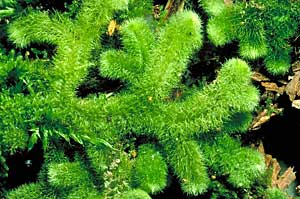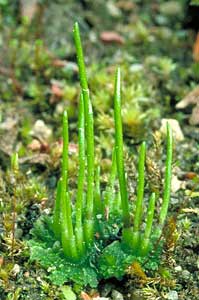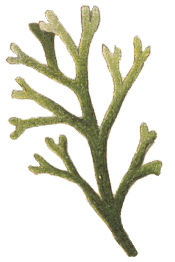
Classification and identification
Before going further it is worth pointing out the difference between classification and identification.
Classification answers questions of the sort: How is this bryophyte related to other bryophytes?
Identification answers the question: What's the name of the specimen in front of me?
Classification deals with evolutionary history and a good classification scheme would group evolutionarily close organisms near one another. This demands a good understanding of many different aspects of bryophyte biology since the different aspects provide different types of evidence regarding relationships. In order to develop a sound classification all the evidence must be assessed.
Identification is a fairly mechanical process and you can identify bryophytes without knowing anything about bryophyte classification. You just need to be able to follow the instructions in a bryophyte identification guide. It's a bit like cooking - if you follow the instructions in the recipe you'll bake yourself a delicious cake. You must be able to recognize things such as eggs, flour and milk but you don't need to know the function of any of these ingredients. Of course, a good cook knows what the ingredients do and can then intelligently substitute ingredients or vary the recipe for particular purposes. Similarly, knowledge of bryophyte classification will give you a better grasp of the bryophyte world, allow you to take intelligent shortcuts in identification and help guard against misunderstandings.
The classification hierarchy
All living organisms have been classified in a hierarchical fashion and the intention of a classification scheme is to have the hierarchy reflect the strengths of the evolutionary relationships between different individuals. Individuals that are closely related from an evolutionary perspective are grouped into the one species. Related species are grouped into a genus (plural: genera). Related genera are grouped into a family and, going to still broader groupings (or higher levels of classification), there are orders, classes, divisions (also called phyla, with phylum the singular) and finally kingdoms. This hierarchical scheme immediately tells you that two individuals in the same species are more closely related to each other than two individuals that, while belonging to the same genus, are members of different species. Each of the words given in bold is an example of a taxonomic rank.
In this hierarchical ordering, the number of species is greater than the number of genera, which in turn is greater than the number of families and so on. When a biologist proposes the creation of a new category at one taxonomic rank, he or she must ensure that the new category contains at least one member at each lower rank. For example, a botanist who wishes to define a new order must ensure that within the new order there is at least one family, which in turn must contain at least one genus, which in turn must contain at least one species.
Sometimes categories finer than species are used, and there can be various categories that are intermediate between the levels that have just been given in bold, for example, subclass (which lies between order and class). However, while they are relevant to a specialist, generally they will be ignored here since they merely introduce technical complexities but illustrate no additional classificatory principles.
What about bryophytes? Bryophytes are plants. Hence, at the highest level bryophytes belong to the Plant Kingdom. Bryophytes are distinguished from other plants by being classified in their own divisions or phyla. For example, the liverworts constitute the division or phylum given the name Marchantiophyta. Some other examples of divisions or phyla in the Plant Kingdom are Magnoliophyta (the flowering plants), Pinophyta (the conifers) and Pteridophyta (ferns and horsetails).
phylum: |
Marchantiophyta |
Magnoliophyta |
Magnoliophyta |
class: |
Jungermanniopsida |
Magnoliopsida |
Liliopsida |
order: |
Lepicoleales |
Fabales |
Poales |
family: |
Trichocoleaceae |
Mimosaceae |
Poaceae |
genus: |
Leiomitra |
Acacia |
Themeda |
species: |
Leiomitra lanata |
Acacia pycnantha |
Themeda triandra |
Note that names of phyla end in –phyta, those of class in –opsida, those of order in –ales and those of family in –aceae. These are standard in botanical terminology. Within the Magnoliophyta the class Magnoliopsida consists of the dicotyledons and the class Liliopsida of the monocotyledons.
On this and the other classification pages you will generally see species or genus names followed, in brackets, by enough information to allow you to deduce the full classification for the species or genus in question. Along with the bracketed information you may also need to use other information that has already been given.
Warning: If you're looking for the full classification hierarchy for every bryophyte, this page is not for you. Nor will this page help you identify bryophyte specimens. Rather, the intent here is to give you some examples of the features or tools used in bryophyte classification or identification and very brief summaries of bryophyte classification schemes. Elsewhere in these Classification and identification pages you'll be told where to find detailed information about bryophyte classification. You'll find identification guides for Australian bryophytes listed on the FURTHER READING page. |
Features used in classification or identification
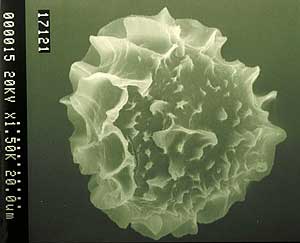 |
At any given time the features used for classification of bryophytes or, indeed, of any group of living organisms depend on the available technology. Several hundred years ago bryophyte classification was based on morphological features visible to the naked eye. Later, botanists were able to use low level magnification, then higher level magnification as light microscopes improved and the 20th century saw the advent of electron microscopes, allowing the examination of very fine morphological detail and cellular structure. Spores of the simple thallose liverwort genus Fossombronia (Fossombroniaceae, Fossombroniales, Jungermanniopsida) develop in groups of four, the four pressed together as a tetrad. For any spore, the face that touches the other three in the tetrad is called the proximal face and the distal face is the one that faces away from the other spores in the tetrad. The accompanying photograph, taken with a scanning electron microscope, shows the proximal surface of a spore of Fossombronia pusilla (right) . Here ![]() is a view of the distal side of a spore of the same species. Here are two photos of spores of Fossombronia alata: proximal
is a view of the distal side of a spore of the same species. Here are two photos of spores of Fossombronia alata: proximal ![]() and distal
and distal ![]() . These images clearly show the differences between proximal and distal faces, as well as differences between those two species of Fossombronia. Apart from spores various other aspects of sporophyte and gametophyte structure have featured in bryophyte classification and you'll see some examples a little later. Analysis of morphology (macroscopic or microscopic) and cellular structure of the mature gametophytes or sporophytes gives useful information but such information is effectively a snapshot from one point in the life of a bryophyte. From the latter part of the 19th century bryologists have studied bryophyte life cycles. Following the cycle from spore through gametophyte to sporophyte and spore again gives information about how features develop. By varying growth conditions it's possible to get some idea as to how environmental conditions influence morphology.
. These images clearly show the differences between proximal and distal faces, as well as differences between those two species of Fossombronia. Apart from spores various other aspects of sporophyte and gametophyte structure have featured in bryophyte classification and you'll see some examples a little later. Analysis of morphology (macroscopic or microscopic) and cellular structure of the mature gametophytes or sporophytes gives useful information but such information is effectively a snapshot from one point in the life of a bryophyte. From the latter part of the 19th century bryologists have studied bryophyte life cycles. Following the cycle from spore through gametophyte to sporophyte and spore again gives information about how features develop. By varying growth conditions it's possible to get some idea as to how environmental conditions influence morphology.
Investigations of chromosomes, internal chemistry and ecological preferences have given additional insights into the differences amongst the bryophytes and, more recently, studies of bryophyte genomes have featured in taxonomic research. A bryophyte's genome is its full hereditary material, stored as DNA, primarily in the cell nucleus but within a bryophyte cell DNA is also found in other organelles - chloroplasts and mitochondria. Chloroplasts contain chlorophyll and it is in chloroplasts that photosynthesis takes place. Mitochondria produce molecules essential for cell function. Chloroplast and mitochondrial DNA are independent of nuclear DNA. Methods that use bryophyte genomes are commonly referred to as molecular methods. Studies of bryophyte genomes are still in their early stages but the genomic evidence has cast doubt on some older classification ideas and supported others. That's not surprising. Whenever a new tool or method has appeared (for example, light microscopes, electron microscopes, growth studies) the information generated by the new tool or method has invariably agreed with some of the then contemporary ideas of bryophyte classification and contradicted others.
If you wish to draw sound conclusions from molecular evidence it is important to study the genomes of a very large number of species. That's no different to past practices. For example, before being able to use sporophyte features in bryophyte classification, the characteristics of sporophytes from a very large number of species had to be known. An additional requirement of genomic analysis is to investigate different parts of the genome of each species. Currently there are still many species for which little or no genomic information is available.
The state of bryophyte classification
While there is much agreement about the classification of bryophytes, there is also considerable debate about various aspects. Ongoing research will undoubtedly lead to revised ideas and different people already hold different interpretations of some of the current evidence. This means that you will see some different views on other websites or in print and on this website there will be a few examples of different points of view. However, in an introductory website such as this one, there is no point in going into great detail about the current debates.
The classification schemes set out in the papers listed in the following Reference button are the starting points for the classification discussions on this website. The moss classification is based on a mixture of molecular, morphological (macroscopic and microscopic) and cell structure data while those of liverworts and hornworts are based primarily on morphology and cellular structure. These provide a good framework on which to build a short account of the principles of bryophyte classification and against which to contrast some findings from later studies. Currently bryophyte classification is in a state of flux, not surprising given the earlier comments about the level of knowledge of bryophyte genomes. While the molecular methods are suggesting new ideas, there is still a need for more molecular evidence and the thorough assessment of that evidence, along with any new non-molecular evidence, before bryophyte classification becomes settled![]() .
.
For the sake of brevity the bryophyte classifications proposed in those papers will be referred to collectively as the 2000 classifications in the classification pages of this website. The few examples that you've already seen on this page have been taken from the 2000 classifications and, under those schemes, the mosses are placed in the division or phylum Bryophyta and the hornworts in Anthocerotophyta.
There are separate pages dealing with:
Each of these pages will give you some examples of features used in bryophyte classification or identification as well as summaries of the higher levels of the 2000 classifications and some comments about research findings since the publication of the 2000 classifications.
The three groups are not presented in a uniform way since the levels of knowledge about the groups vary considerably. You'll see that hornwort classification is in the greatest state of flux. Hornworts and liverworts are of interest beyond the bryophytes. research has shown that a better understanding of liverwort and hornwort relationships and evolution is critical to a proper understanding of land plant evolution, in particular the transition from water to land and the change from haploid-dominant to diploid-dominant. The reference button directs you a technical paper about this work, but you can find a less technical account at this link![]() .
.
Identification again
There are obviously connections between the processes of classification and identification but, as made clear at the top of this page, they are not identical. Features that are used in classification are often used in identification but it's not obligatory. As knowledge has advanced, some features once thought to be important in bryophyte classification have been found to be of lesser, or even no, importance. That phenomenon is not confined to bryophytes for the same has happened in the classifications of all groups of organisms. While a feature might lose its usefulness in classification that feature can still be useful for identification.
In the practical process of identification bryologists use whatever features most easily let them correctly identify species. The LIVERWORT CLASSIFICATION page revealed that recent molecular results point to the leafy liverwort genus Pleurozia being more closely related to simple thallose liverworts than it is to the other leafy liverworts. That has to do with classification and does not invalidate the past methods used in identification. Whatever characteristics of leafy liverworts let you previously correctly identify Pleurozia still let you correctly identify Pleurozia. The genus hasn't changed. It has exactly the same characteristics that it previously had. What has changed is its pigeonhole in the classification scheme.
Hence even in these days, when various high tech tools are being used to find out more about the biology of bryophytes, low tech methods are still being used to identify specimens. Numerous gametophyte and sporophyte features are still used as the standard ways of identifying bryophyte specimens.
Here, for example, are some questions you might be asked in a moss identification guide.
- Is the gametophyte colony dark green
 or very hoary in appearance
or very hoary in appearance  ?
?
- Is the mature spore capsule upright
 or nodding
or nodding  ?
?
- When dry, do the leaves twist around the stem
 or simply fold inwards to the stem
or simply fold inwards to the stem  ?
?
- Does the leaf have a nerve
 or not ?
or not ?
- Are the cells in the lower leaf corners markedly different from the other leaf cells?
- How large are the spores?
Some of these questions can be answered with the naked eye. For some you'd need a hand lens magnifying about ten times. Each leaf of the moss Tortula princeps has a nerve running along the leaf's central axis and extending into a hairpoint at the apex of the leaf. Many people will be able to see these features with the naked eye, but others will need the help of a low power magnifier. When it comes to cell features or spore sizes a microscope magnifying several hundred times will be necessary. The pictorial finish to this page has been provided by Judith Curnow and shows drawings of a few spores of the moss Physcomitrium pyriforme ![]() . In this species the spore diameters are between 25 and 35 micrometres.
. In this species the spore diameters are between 25 and 35 micrometres.
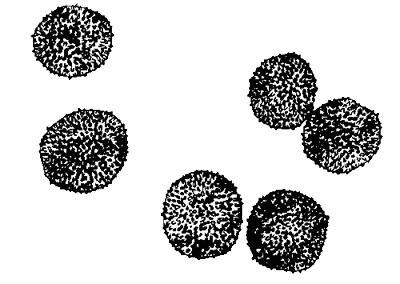
![An Australian Government Initiative [logo]](/images/austgovt_brown_90px.gif)


